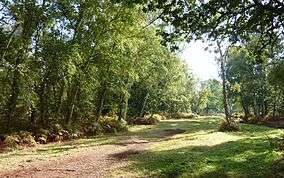Holme Fen
Holme Fen is a 269.4 hectare biological Site of Special Scientific Interest near Holme in Cambridgeshire.[1][2] It is also a National Nature Reserve[3] and a Nature Conservation Review site, Grade I.[4] It is part of the Great Fen project, which aims to create a 3,700 wetland wildlife area including Holme Fen, Woodwalton Fen and other areas.[5] It is home to a variety of birds, including the Eurasian siskin, Nightingale and Lesser redpoll, and around 450 species of fungi.[6]
| Site of Special Scientific Interest | |
 | |
| Area of Search | Cambridgeshire |
|---|---|
| Grid reference | TL 206 889[1] |
| Interest | Biological |
| Area | 269.4 hectares[1] |
| Notification | 1985[1] |
| Location map | Magic Map |
Home Fen is described by Natural England as the finest example of birch woodland in lowland Britain. Part of it was a mere which was drained in the nineteenth century, and some relict wetland plants survive such as saw sedge and fen wood-rush.[7] Two new lakes have been excavated.[5]
Holme Fen, specifically Holme Posts, is believed to be the lowest land point in Great Britain at 2.75 metres (9.0 ft) below sea level.[6][8]
History
In October 2015, archaeological work to recover a WW2 Spitfire, flown by Pilot Officer Harold Penketh, that crashed into Holme Fen on 22 November 1940, was undertaken. Led by Oxford Archaeology East's project director Stephen Macauley, the teams located and recovered artefacts from the crash. A film of the excavation was shown at the Great Fen's Countryside Centre, Ramsey Heights on 27 September, 2019.[9]
Access
The reserve is open to the public throughout the year. Several footpaths cross the site.
Management
Holme Fem is at the south-western edge of the former Whittlesey Mere, which has been drained. The Great Fen Project aims to reconnect Holme Fen with nearby Woodwalton Fen, another vestigial fragment of wild fenland. Holme approximately marks the south-western limit of Stage 2 of the Great Fen Project.
References
- "Designated Sites View: Holme Fen". Sites of Special Scientific Interest. Natural England. Retrieved 10 December 2016.
- "Map of Holme Fen". Sites of Special Scientific Interest. Natural England. Retrieved 10 December 2016.
- "Cambridgeshire's National Nature Reserves". Natural England. Retrieved 10 December 2016.
- Ratcliffe, Derek, ed. (1977). A Nature Conservation Review. 2. Cambridge, UK: Cambridge University Press. pp. 56–57. ISBN 0521 21403 3.
- "Great Fen". Wildlife Trust for Bedfordshire, Cambridgeshire and Northamptonshire. Retrieved 10 December 2016.
- "Holme Fen NNR". 2008.
- "Holme Fen citation" (PDF). Sites of Special Scientific Interest. Natural England. Retrieved 10 December 2016.
- "UK's lowest spot is getting lower". BBC. 2002-11-29. Retrieved 2010-01-05.
- Fitton, Caroline (2019). "Great Fen Spitfire revisited". The Fens: Wisbech & Surrounding. 18: 32.
| Wikimedia Commons has media related to Holme Fen. |